The global surgical robot procedures market is forecasted to grow from USD 14.2 billion in 2025 to approximately USD 70.2 billion by 2035, recording an absolute increase of USD 56.0 billion over the forecast period. This translates into a total growth of 394.4%, with the market forecast to expand at a CAGR of 17.3% between 2025 and 2035. The market size is expected to grow by nearly 4.9X during the same period, supported by increasing adoption of minimally invasive surgical techniques, rising demand for precision surgery, and growing investment in healthcare robotics infrastructure.

Between 2025 and 2030, the surgical robot procedures market is projected to expand from USD 14.2 billion to USD 31.6 billion, resulting in a value increase of USD 17.4 billion, which represents 31.1% of the total forecast growth for the decade. This phase of growth will be shaped by rising hospital investments in robotic surgical systems, increasing surgeon training programs, and growing patient preference for minimally invasive procedures. Healthcare providers are expanding their robotic surgery capabilities to address the growing demand for precision surgical interventions across multiple specialties.
| Metric | Value |
|---|---|
| Estimated Value in (2025E) | USD 14.2 billion |
| Forecast Value in (2035F) | USD 70.2 billion |
| Forecast CAGR (2025 to 2035) | 17.3% |
From 2030 to 2035, the market is forecast to grow from USD 31.6 billion to USD 70.2 billion, adding another USD 38.6 billion, which constitutes 68.9% of the ten-year expansion. This period is expected to be characterized by widespread adoption of AI-integrated robotic systems, development of specialized surgical robots for niche procedures, and expansion of robotic surgery capabilities to smaller healthcare facilities. The growing acceptance of telesurgery and remote surgical assistance will drive demand for advanced robotic surgical platforms with enhanced connectivity and precision control systems.
Between 2020 and 2025, the surgical robot procedures market experienced robust expansion, driven by accelerated healthcare digitization and growing focus on surgical precision and patient safety. The market developed as healthcare systems recognized the benefits of robotic-assisted surgery in reducing complications, shortening recovery times, and improving surgical outcomes. COVID-19 pandemic highlighted the importance of minimally invasive procedures and contactless surgical technologies, further accelerating adoption rates.
Market expansion is being supported by the increasing recognition of robotic surgery benefits including enhanced precision, reduced invasiveness, shorter hospital stays, and improved patient outcomes. Healthcare providers are increasingly investing in robotic surgical systems to differentiate their services, attract top surgical talent, and meet growing patient demand for minimally invasive treatment options. The proven efficacy of robotic-assisted procedures in complex surgeries across urology, gynecology, and orthopedic specialties is driving adoption rates.
The growing focus on value-based healthcare and improved surgical outcomes is creating demand for robotic surgical solutions that demonstrate measurable benefits in patient recovery times, reduced complications, and overall healthcare cost reduction. Technological advancements including AI integration, enhanced haptic feedback, and improved imaging capabilities are making robotic surgery more accessible and effective across a broader range of procedures. The increasing availability of surgeon training programs and certification pathways is also contributing to market growth by expanding the pool of qualified robotic surgeons.
The market is segmented by application, procedure type, procedure complexity, end-use, and region. By application, the market is divided into urology, general surgery, gynecology, orthopedics, cardiothoracic, neurosurgery, ENT (otolaryngology), bariatric/metabolic, and other specialties. Based on procedure type, the market is categorized into minimally-invasive laparoscopic robotic-assisted, percutaneous/catheter-based robotic procedures, endoscopic robotic procedures, open-assisted (hybrid open procedures), and others. In terms of procedure complexity, the market is segmented into low complexity (simple laparoscopic cases), medium complexity (advanced laparoscopy, joint replacements), and high complexity (oncologic, cardiac, neuro). By end-use, the market is classified into large hospital systems (multi-facility), standalone hospitals/private hospitals, specialty clinics/ASCs, and others. Regionally, the market is divided into North America, Europe, East Asia, South Asia & Pacific, Latin America, and Middle East & Africa.
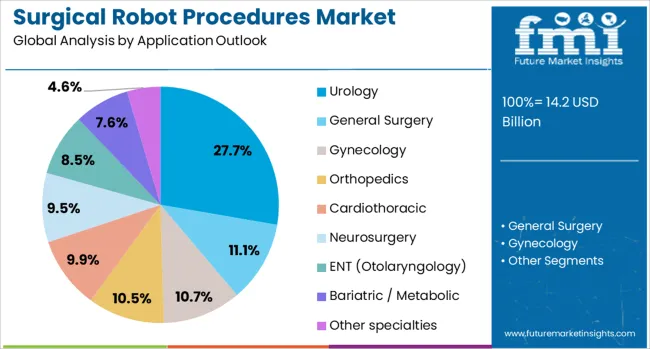
The urology application is projected to account for 27.7% of the surgical robot procedures market in 2025, reaffirming its position as the leading specialty for robotic surgery adoption. The segment benefits from the high suitability of urological procedures for robotic assistance, particularly in prostatectomies, nephrectomies, and complex reconstructive surgeries. Robotic systems provide enhanced visualization, precision, and dexterity in the confined pelvic anatomy, leading to improved surgical outcomes and reduced complications.
This application forms the foundation of robotic surgery adoption in many healthcare facilities, as urological procedures demonstrate clear clinical benefits including reduced blood loss, shorter hospital stays, and faster patient recovery. The growing prevalence of urological cancers and kidney diseases, combined with an aging population requiring surgical intervention, ensures steady growth in this segment. Continuous technological improvements in robotic platforms specifically designed for urological procedures continue to expand the range of treatable conditions and surgical approaches.
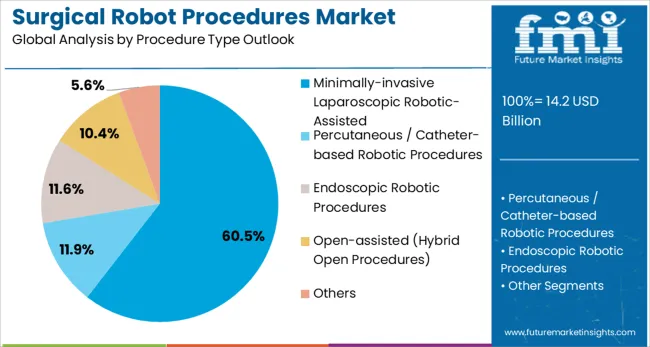
Minimally-invasive laparoscopic robotic-assisted procedures are projected to represent 60.5% of surgical robot procedures demand in 2025, underscoring their role as the preferred approach for robotic surgery. This procedure type offers significant advantages over traditional open surgery including smaller incisions, reduced tissue trauma, faster recovery times, and improved cosmetic outcomes. The combination of laparoscopic visualization with robotic precision creates optimal conditions for complex surgical procedures.
The segment is supported by continuous technological advancements in robotic platforms that enhance surgeon capabilities through improved ergonomics, tremor filtering, and motion scaling. The growing acceptance among patients and surgeons of minimally invasive approaches drives adoption across multiple specialties. As surgical training programs increasingly emphasize minimally invasive techniques and robotic proficiency, this segment will continue to dominate the market while expanding into new therapeutic areas and surgical procedures.
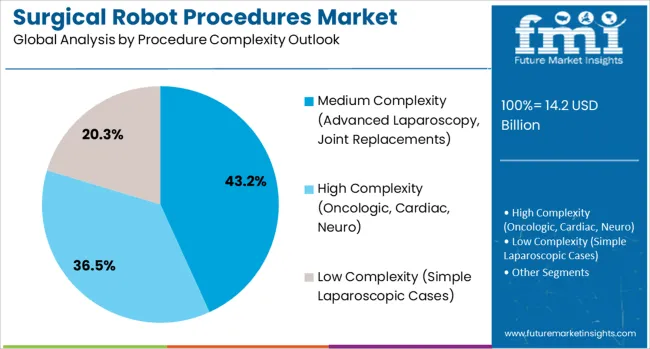
The medium complexity procedure segment is forecasted to contribute 43.2% of the surgical robot procedures market in 2025, reflecting the sweet spot where robotic assistance provides maximum value over traditional surgical approaches. This category includes advanced laparoscopic procedures and joint replacements that benefit significantly from robotic precision while remaining accessible to a broad range of surgical teams and healthcare facilities.
Medium complexity procedures represent the optimal balance between clinical benefits and economic viability, making them attractive for healthcare providers seeking to expand their robotic surgery programs. The segment benefits from established clinical protocols, surgeon training programs, and proven outcome data that support adoption decisions. As robotic technology continues to mature and costs decrease, medium complexity procedures serve as the entry point for many healthcare facilities beginning their robotic surgery journey.
The surgical robot procedures market is advancing rapidly due to increasing demand for minimally invasive surgery, growing surgeon acceptance of robotic technology, and expanding healthcare investments in surgical robotics. The market faces challenges including high capital costs, limited surgeon training availability, and integration complexity with existing hospital systems. Innovation in AI-assisted surgery and expansion of training programs continue to influence market development and adoption patterns.
The incorporation of AI and machine learning capabilities into robotic surgical systems is revolutionizing surgical precision and decision-making. These technologies enable real-time surgical guidance, predictive analytics for surgical outcomes, and automated instrument control for routine surgical tasks. AI integration helps reduce surgical variability, improve consistency across procedures, and provide valuable insights for continuous improvement in surgical techniques and patient care protocols.
The development of comprehensive training programs and standardized certification pathways is addressing the surgeon skill gap that has historically limited robotic surgery adoption. Medical institutions, technology companies, and professional societies are collaborating to establish robust training curricula that combine simulation-based learning, mentorship programs, and hands-on experience. These initiatives are expanding the pool of qualified robotic surgeons while ensuring consistent quality and safety standards across healthcare facilities.
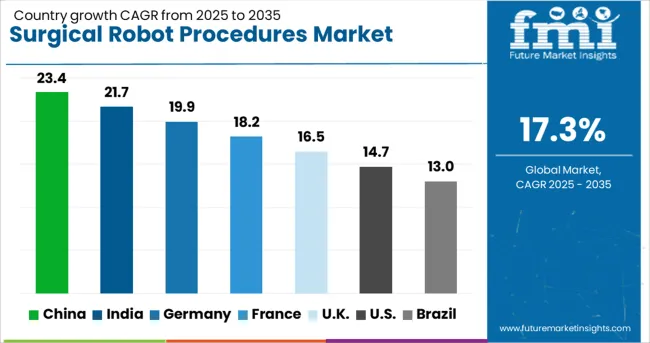
| Country | CAGR (2025-2035) |
|---|---|
| China | 23.4% |
| India | 21.7% |
| Germany | 19.9% |
| France | 18.2% |
| UK | 16.5% |
| USA | 14.7% |
| Brazil | 13% |
The surgical robot procedures market is experiencing exceptional growth globally, with China leading at a 23.4% CAGR through 2035, driven by massive healthcare infrastructure investments, government support for medical technology adoption, and rapidly expanding hospital networks. India follows closely at 21.7%, supported by growing medical tourism, increasing healthcare spending, and rising demand for advanced surgical treatments. Germany shows strong growth at 19.9%, emphasizing precision engineering applications in medical robotics and comprehensive healthcare system integration. The report covers an in-depth analysis of 40+ countries; top-performing countries are highlighted below.
Revenue from surgical robot procedures in China is projected to exhibit exceptional growth with a CAGR of 23.4% through 2035, driven by government initiatives supporting healthcare modernization and substantial investments in medical technology infrastructure. The country's expanding hospital networks and growing middle class are creating significant demand for advanced surgical services and minimally invasive treatment options. Major international and domestic medical technology companies are establishing comprehensive distribution networks and training centers to serve the rapidly expanding market.
Revenue from surgical robot procedures in India is expanding at a CAGR of 21.7%, supported by increasing healthcare investments, growing medical tourism industry, and rising demand for advanced surgical treatments. The country's large population base and increasing healthcare awareness are driving demand for minimally invasive surgical options and improved patient outcomes. International medical technology companies and domestic healthcare providers are establishing partnerships to expand robotic surgery accessibility across urban and semi-urban markets.

Demand for surgical robot procedures in the USA is projected to grow at a CAGR of 14.7%, supported by comprehensive healthcare infrastructure, strong reimbursement systems, and widespread surgeon training programs. American healthcare providers continue to lead global adoption of robotic surgical technologies, with extensive experience across multiple specialties and procedure types. The market is characterized by continuous innovation, robust clinical research, and strong partnerships between medical institutions and technology companies.
Revenue from surgical robot procedures in Germany is projected to grow at a CAGR of 19.9% through 2035, supported by the country's strong healthcare system, focus on medical technology innovation, and comprehensive quality standards. German healthcare providers prioritize clinical efficacy, patient safety, and technological precision, making robotic surgery an attractive option for complex procedures requiring enhanced precision and control.
Revenue from surgical robot procedures in France is projected to grow at a CAGR of 18.2% through 2035, supported by comprehensive healthcare system support, medical technology investment, and focus on minimally invasive surgical approaches. French healthcare providers are integrating robotic surgery capabilities across major medical centers while maintaining focus on clinical outcomes and patient safety standards.
Revenue from surgical robot procedures in the UK is projected to grow at a CAGR of 16.5% through 2035, supported by National Health Service initiatives, medical technology partnerships, and focus on improved surgical outcomes. British healthcare providers are strategically implementing robotic surgery programs to enhance patient care while managing healthcare costs and improving operational efficiency.
Revenue from surgical robot procedures in Brazil is projected to grow at a CAGR of 13% through 2035, supported by healthcare system modernization, increasing medical technology investment, and growing demand for advanced surgical services. Brazilian healthcare providers are expanding robotic surgery capabilities to serve both domestic patients and the growing medical tourism market.
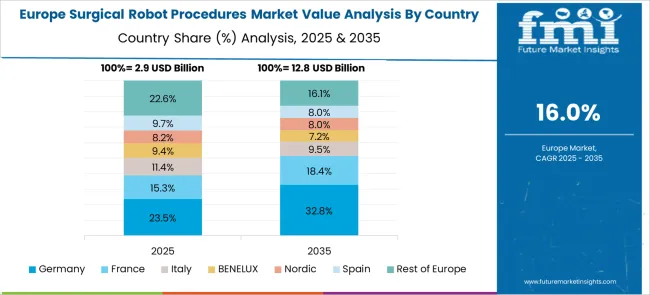
The European surgical robot procedures market demonstrates sophisticated development across major economies with Germany leading through its precision engineering excellence and advanced medical robotics capabilities, supported by companies emphasizing comprehensive robotic surgical systems, AI-integrated platforms, and minimally invasive surgical solutions while maintaining strict quality standards and clinical validation protocols. The UK shows strength in healthcare system integration and medical technology partnerships, with organizations specializing in innovative robotic surgery programs and evidence-based surgical approaches that meet rigorous clinical standards.
France contributes through its healthcare system support and medical technology investment programs, delivering advanced robotic surgical solutions that combine traditional surgical expertise with modern robotic precision for enhanced patient outcomes. Sweden and Nordic countries emphasize patient-centred healthcare approaches and innovative medical technology development. Italy and Spain demonstrate growth in specialized surgical applications and healthcare infrastructure modernization. The market benefits from stringent EU medical device regulations, established clinical research infrastructure, and growing demand for minimally invasive surgical solutions that provide superior patient outcomes and operational efficiency.
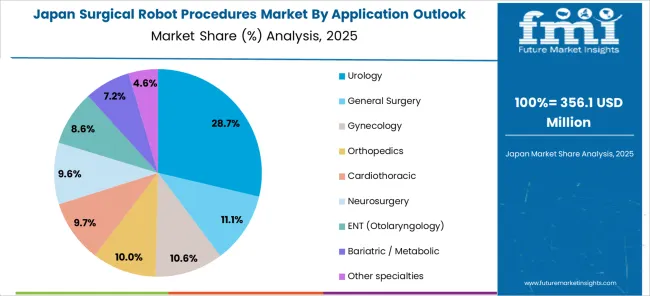
The Japanese surgical robot procedures market demonstrates steady growth driven by precision healthcare focus, advanced medical technology development, and healthcare system preference for high-quality robotic surgical systems that ensure superior precision and clinical efficacy throughout complex surgical procedures. Japanese organizations prioritize sophisticated robotic platforms and comprehensive quality assurance systems, creating demand for surgical robots featuring advanced precision control, integrated imaging systems, and comprehensive surgical instrumentation that align with Japanese medical excellence standards.
The market emphasizes technological innovation in surgical robotics, AI integration, and patient outcome optimization that reflects Japanese attention to detail in medical device development and surgical care delivery. Growing investment in aging population healthcare solutions and surgical innovation supports adoption of next-generation robotic surgical platforms with enhanced precision capabilities, minimally invasive approaches, and comprehensive training programs for optimal surgical outcomes. Japanese healthcare providers focus on system reliability, consistent clinical performance, and long-term patient benefit through advanced robotic surgery implementation.
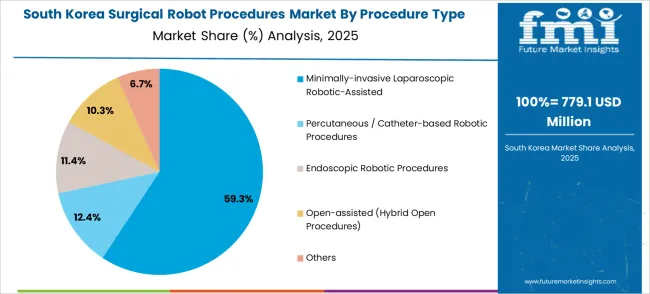
The South Korean surgical robot procedures market shows exceptional growth potential driven by expanding healthcare infrastructure, increasing adoption of advanced surgical technologies, and growing demand for sophisticated robotic surgery solutions requiring comprehensive clinical efficacy and precision control capabilities. The market benefits from South Korea's technological leadership in robotics and electronics and increasing focus on healthcare modernization that drives investment in advanced surgical robotics platforms meeting international clinical standards.
Korean healthcare organizations increasingly adopt advanced robotic surgical systems, AI-powered surgical platforms, and integrated navigation technologies to improve surgical outcomes and patient recovery while ensuring cost-effectiveness requirements. Growing influence of Korean medical technology companies and surgical innovation initiatives supports demand for sophisticated robotic surgery solutions that ensure comprehensive functionality while maintaining clinical accessibility and eco-friendly healthcare practices. The integration of artificial intelligence and machine learning technologies creates opportunities for next-generation surgical robotics with enhanced precision, predictive analytics, and personalized surgical planning capabilities.
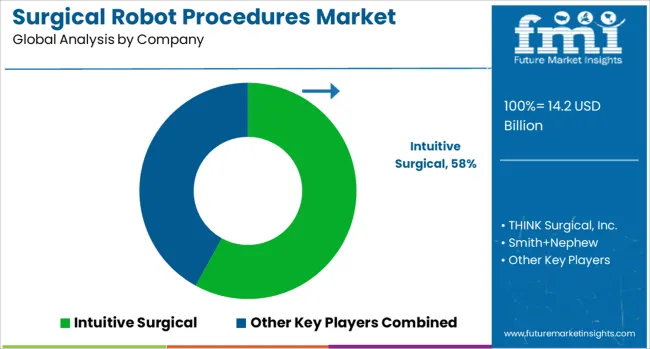
The surgical robot procedures market is characterized by intense competition among established medical technology companies, innovative robotics firms, and emerging surgical platform developers. Companies are investing in next-generation robotic systems, AI integration, surgeon training programs, and comprehensive service support to deliver effective, safe, and accessible robotic surgical solutions. Technology innovation, clinical validation, and market expansion are central to strengthening product portfolios and market presence.
Intuitive Surgical, Inc. , USA-based, leads the market with 58.0% global value share, offering the da Vinci surgical system platform with comprehensive surgeon training and clinical support programs. THINK Surgical Inc., USA, provides specialized orthopedic robotic systems with focus on precision joint replacement procedures. Smith+Nephew, UK, delivers advanced robotic platforms for orthopedic and sports medicine applications with focus on minimally invasive techniques.
Medtronic, USA, offers comprehensive robotic surgical solutions across multiple specialties with integration capabilities for existing healthcare infrastructure. Stryker, USA, focuses on orthopedic and neurosurgical robotic systems with advanced navigation and precision control capabilities. Zimmer Biomet, USA, provides specialized robotic platforms for joint replacement and orthopedic procedures with focus on improved patient outcomes.
CMR Surgical, UK, develops next-generation surgical robots with focus on accessibility and ease of use across diverse healthcare settings. Asensus Surgical US Inc., USA, offers advanced laparoscopic robotic systems with machine vision and AI-assisted capabilities. Renishaw PLC, UK, provides precision surgical robotics for neurosurgical applications with focus on accuracy and patient safety. MOON Surgical, France, develops innovative robotic surgical assistants with focus on surgeon workflow optimization.
| Items | Values |
|---|---|
| Quantitative Units (2025) | USD 14.2 billion |
| Application | Urology, General Surgery, Gynecology, Orthopedics, Cardiothoracic, Neurosurgery, ENT (Otolaryngology), Bariatric/Metabolic, Other specialties |
| Procedure Type | Minimally-invasive Laparoscopic Robotic-Assisted, Percutaneous/Catheter-based Robotic Procedures, Endoscopic Robotic Procedures, Open-assisted (Hybrid Open Procedures), Others |
| Procedure Complexity | Low Complexity (Simple Laparoscopic Cases), Medium Complexity (Advanced Laparoscopy, Joint Replacements), High Complexity (Oncologic, Cardiac, Neuro) |
| End-use | Large Hospital Systems (Multi-facility), Standalone Hospitals/Private Hospitals, Specialty Clinics/ASCs, Others |
| Regions Covered | North America, Europe, East Asia, South Asia & Pacific, Latin America, Middle East & Africa |
| Countries Covered | United States, Canada, United Kingdom, Germany, France, China, Japan, South Korea, India, Brazil, Australia and 40+ countries |
| Key Companies Profiled | Intuitive Surgical, Inc., THINK Surgical Inc., Smith+Nephew, Medtronic, Stryker, Zimmer Biomet, CMR Surgical, Asensus Surgical US Inc., Renishaw PLC, and MOON Surgical |
| Additional Attributes | Dollar sales by procedure type and complexity level, regional adoption trends, competitive landscape, surgeon training requirements, integration with hospital systems, innovations in AI-assisted surgery, haptic feedback systems, and telesurgery capabilities |
The global surgical robot procedures market is estimated to be valued at USD 14.2 billion in 2025.
The market size for the surgical robot procedures market is projected to reach USD 70.2 billion by 2035.
The surgical robot procedures market is expected to grow at a 17.3% CAGR between 2025 and 2035.
The key product types in surgical robot procedures market are urology, general surgery, gynecology, orthopedics, cardiothoracic, neurosurgery, ent (otolaryngology), bariatric / metabolic and other specialties.
In terms of procedure type outlook, minimally-invasive laparoscopic robotic-assisted segment to command 60.5% share in the surgical robot procedures market in 2025.






Our Research Products

The "Full Research Suite" delivers actionable market intel, deep dives on markets or technologies, so clients act faster, cut risk, and unlock growth.

The Leaderboard benchmarks and ranks top vendors, classifying them as Established Leaders, Leading Challengers, or Disruptors & Challengers.

Locates where complements amplify value and substitutes erode it, forecasting net impact by horizon

We deliver granular, decision-grade intel: market sizing, 5-year forecasts, pricing, adoption, usage, revenue, and operational KPIs—plus competitor tracking, regulation, and value chains—across 60 countries broadly.

Spot the shifts before they hit your P&L. We track inflection points, adoption curves, pricing moves, and ecosystem plays to show where demand is heading, why it is changing, and what to do next across high-growth markets and disruptive tech

Real-time reads of user behavior. We track shifting priorities, perceptions of today’s and next-gen services, and provider experience, then pace how fast tech moves from trial to adoption, blending buyer, consumer, and channel inputs with social signals (#WhySwitch, #UX).

Partner with our analyst team to build a custom report designed around your business priorities. From analysing market trends to assessing competitors or crafting bespoke datasets, we tailor insights to your needs.
Supplier Intelligence
Discovery & Profiling
Capacity & Footprint
Performance & Risk
Compliance & Governance
Commercial Readiness
Who Supplies Whom
Scorecards & Shortlists
Playbooks & Docs
Category Intelligence
Definition & Scope
Demand & Use Cases
Cost Drivers
Market Structure
Supply Chain Map
Trade & Policy
Operating Norms
Deliverables
Buyer Intelligence
Account Basics
Spend & Scope
Procurement Model
Vendor Requirements
Terms & Policies
Entry Strategy
Pain Points & Triggers
Outputs
Pricing Analysis
Benchmarks
Trends
Should-Cost
Indexation
Landed Cost
Commercial Terms
Deliverables
Brand Analysis
Positioning & Value Prop
Share & Presence
Customer Evidence
Go-to-Market
Digital & Reputation
Compliance & Trust
KPIs & Gaps
Outputs
Full Research Suite comprises of:
Market outlook & trends analysis
Interviews & case studies
Strategic recommendations
Vendor profiles & capabilities analysis
5-year forecasts
8 regions and 60+ country-level data splits
Market segment data splits
12 months of continuous data updates
DELIVERED AS:
PDF EXCEL ONLINE
Surgical Tourniquet Market Size and Share Forecast Outlook 2025 to 2035
Surgical Operating Microscope Market Forecast and Outlook 2025 to 2035
Surgical Heart Valves Market Size and Share Forecast Outlook 2025 to 2035
Surgical Aspirators Market Size and Share Forecast Outlook 2025 to 2035
Surgical Wound Care Market Size and Share Forecast Outlook 2025 to 2035
Surgical Retractors Market Size and Share Forecast Outlook 2025 to 2035
Surgical Drainage Devices Market Size and Share Forecast Outlook 2025 to 2035
Surgical Booms Market Insights - Size, Share & Industry Growth 2025 to 2035
Surgical Scissors Market Size and Share Forecast Outlook 2025 to 2035
Surgical Instruments Tracking System Market Growth - Trends & Forecast 2025 to 2035
Surgical Instruments Packaging Market Size, Share & Forecast 2025 to 2035
Surgical Monitors Market Analysis - Industry Insights & Forecast 2025 to 2035
Surgical Scalpels Market Trends – Growth & Forecast 2025-2035
Surgical Generators Market – Trends & Forecast 2025 to 2035
Surgical Gloves Market Trends - Size, Demand & Forecast 2025 to 2035
Surgical Clips Market Analysis - Size, Share & Forecast 2025 to 2035
Surgical Mask Market Insights - Growth & Forecast 2025 to 2035
Surgical Drapes Market Overview - Growth, Demand & Forecast 2025 to 2035
Surgical Stapling Device Market is segmented by product, Usage Type, Stapling Type, Indication and End User from 2025 to 2035
Key Companies & Market Share in the Surgical Scrub Sector

Thank you!
You will receive an email from our Business Development Manager. Please be sure to check your SPAM/JUNK folder too.
Chat With
MaRIA